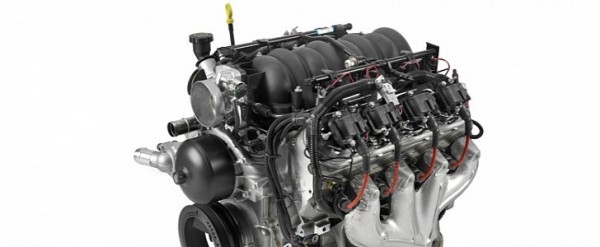 29 photos
29 photos




























All told, Cadillac was the first automaker to mass-produce the V8 engine. Introduced in 1914, the Cadillac Type 51 L-head V8 produced 70 horsepower from a displacement of 5.15 liters (314 cu. in.). But then again, Cadillac didn’t make the V8 popular. It was Ford who did that when it introduced a V8 in its engine lineup.
By the 1950s, the V8 became the most popular engine choice in the United States, with the height of their popularity being in the 1970s, right before the oil crisis came on the scene. To this day, motors with eight cylinders arranged in a V are the go-to configuration for most domestic automobiles.
From all the V8s that were bestowed upon us over the years, some of the most important designs come in the form of the GM LS Generation III and IV small-block V8 engines. It might have started life as a clean sheet design, but the creators of the GM LS engine family didn’t ignore the historical importance and timeless appeal of the classic small-block V8. General Motors introduced the LS series in the then-new 1997 Corvette (C5).
Known as the LS1 small-block V8, this motor eventually replaced the LT1 small-block V8 of the Chevrolet Camaro. Whereas these go-faster machines were animated by the aluminum version of the LS1, trucks and SUVs used the iron-block version of the motor. Similar to the previous-gen small-block V8, the LS1 eight-cylinder mill displaces 5.7 liters.
The Gen III family spawned the high-performance LS6 in 1999 for the Chevrolet Corvette Z06. Finally, the Gen IV LS engine family was born in 2005. Differences over the Gen III include cast-in provisions for fuel-saving cylinder deactivation technology and updated camshaft sensing. Taken together, the Gen III and Gen IV families include iron-block V8s ranging from 4.8 to 5.3 liters plus 6-liter and 6.2-liter premium engines. As for the cast aluminum engines, the GM LS family comes in 5.3, 5.7, 6.0, 6.2, and 7-liter displacements.
Even though there are some significant differences between the Gen III and Gen IV, all LS family engines share some common features. These include the 4.40-inch bore centers (similar to the original Chevrolet small-block V8), six-bolt cross-bolted main bearing caps, a center main thrust bearing, 9.24-inch deck height, 4-bolt per cylinder head bolt pattern, 0.842-inch lifter bores, as well as a distributor-less coil-near-plug ignition system.
The LS family might have been replaced by the Gen V LT in 2013, yet the LS soldiers on in the Chevrolet Silverado HD and GMC Sierra HD pickup trucks. Because the Gen IV LS is nearing the end of its career, the autoevolution team has decided that the time is right to name the bread winners that come to mind from the 30+ different versions of LS V8 engines.LS1 and LS6
Produced between the 1997 and 2004 model years, the 5.7-liter (346 c
u.in.) LS1 V8 has animated models such as the Corvette (C5), Camaro, as well as the GTO and Firebird. 2001 saw the introduction of the LS6 in the Corvette Z06. Until its demise in 2005, the mighty LS6 was also found in the Cadillac CTS-V. Whereas the LS1 and LS6 share the 5.7-liter displacement, the LS6 engine differs from the LS1 V8 with a much stronger block, improved bay-to-bay breathing, and more capable heads, intake manifolds, and camshaft.LS2
It was 2005 when the Gen IV design debuted with the 6-liter (364 cu.in.) LS2 V8 engine. Offered in the Corvette, Pontiac G8 GT, Pontiac GTO, and the hideous Chevrolet SSR, the LS2’s larger displacement came with greater output compared to the LS1. In terms of interchangeability, the LS1, LS6, LS3, and L92 cylinder heads work well on the LS2 motor.LS3 and L99
The LS3 announced the era of unprecedented performance for the Chevrolet Corvette. First seen under the hood of the 2008 model year Corvette, the LS3 brought 430 horsepower to the table from 6.2-liter (376 cu.in.) displacement. At the time, the LS3 was the most powerful base Corvette engine ever. Boasting larger bores than the LS2, the LS3 was also offered on models such as the Pontiac G8 GXP and the 2010 model year Chevrolet Camaro. As for the L99 variant, this fuel-efficient motor is standard on the 2010 Camaro SS automatic and its selling point is the Active Fuel Management cylinder deactivation system.LS4
Oh, where do we start with the LS4? Commonly labeled as the most intriguing engine of the LS family, the LS4 is a 5.3-liter lump that equipped the front-wheel drive (yes, FWD) Chevrolet Impala SS and Pontiac Grand Prix GXP. The 303 horsepower LS4 features a transverse mounting position, which sort of spoils everything that’s good about this engine.LS7
The legendary LS7 was the focus point of the sixth-generation Chevrolet Corvette Z06. Its 7-liter (427 cu.in.) displacement made it the largest LS offered in a production vehicle. To cope with the 4.125-inch bores, engineers gave the LS7 a Siamese-bore cylinder block design. Hand-built at the GM Performance Build Center in Wixom, Michigan, the LS7 Vee-Eight blunderbuss was good for 505 horsepower when it was new thanks to go-faster components, such as competition-proven heads, titanium rods, and titanium intake valves.LS9
Before the Gen V LT4 and its 650 all-American horsepower, the LS9 claimed the title of most powerful production engine made by General Motors. The 6.2-liter supercharged and charge-cooled motor powered the Corvette ZR1 with 638 horsepower. Components that made this output possible include a 2.3-liter Roots-type supercharger, dry-sump lubrication, and roto-cast cylinder heads.LSA
For most, the LSA is nothing more than a detuned LS9. Standard in the 2009 Cadillac CTS-V, the 6.2-liter supercharged LSA V8 differed from the LS9 with a distinct charge-cooler system, a 1.9-liter supercharger, hypereutectic pistons versus the LS9’s forged pistons, and so forth. That’s why the former-gen Cadillac CTS-V uber sedan was good for 556 horsepower instead of the Chevrolet Corvette ZR1’s 638 horsepower.








